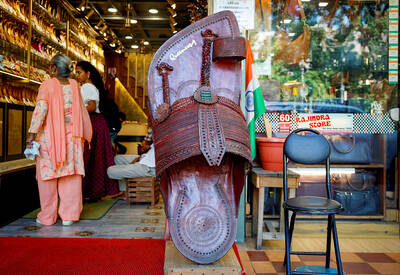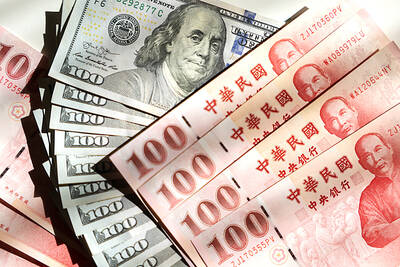Taiwan Semiconductor Manufacturing Co (TSMC, 台積電), the world’s top contract chipmaker, yesterday said it planned to start mass-producing next-generation 450mm wafers using advanced 10-nanometer technology in 2018.
The plan was included in the latest technology roadmap unveiled by TSMC about one year after the chipmaker attributed its delay in making 450mm wafers, originally scheduled in 2015, to semiconductor equipment suppliers’ postponement in developing advanced equipment for manufacturing amid the industrial slump.
The 450mm wafers would help solve the problem of rising costs in making advanced chips, allowing TSMC to provide affordable 10 nanometer chips with FinFET transistors for customers, J.K. Wang (王建光), vice president of TSMC’s operation in charge of 300mm factories, told a media briefing arranged by semiconductor industry association SEMI.
Cost constraints rather than technological constraints for chipmakers to migrate to next-generation chips via shrinking chip geometry, he said.
Chipmakers can get 2.5 times more chips from a 450mm wafer than from a 300mm wafer.
The advanced 10-nanometer chips could first be used in mobile devices and other consumer electronics, like game consoles, that demand high-performance and low power consumption, Wang said.
TSMC planned to build a pilot production line to make 450mm wafers between 2016 and 2017, when semiconductor ASML Holding NV had its key equipment ready in 2015, Wang said.
The chipmaker would consider building major 450mm-wafer production lines in Greater Taichung, he said.
Early this year, TSMC joined the Global 450 Consortium in a move to facilitate the transition of 450mm wafer production from its current 300mm wafers in collaboration with the world’s major chip companies, Intel Corp, Samsung Electronics Co, IBM Corp and GlobalFoundries Inc, Wang said.
Each company sent 20 engineers to jointly develop the technology and overcome challenges, Wang said.
Taiwanese chipmakers are expected to spend 8 percent more on semiconductor equipment to U$9.2 billion this year from last year’s US$8.2 billion, primarily driven by contract chipmakers, TSMC in particular, SEMI analyst Clark Tseng (曾瑞榆) said.
That was a contrast to an annual decline of 2.6 percent in spending by global chip companies this year, SEMI said.
TSMC planned to spend US$8.5 billion on new equipment this year.
Next year, Tseng expects local chipmakers to budget more than US$9 billion in total on new semiconductor equipment, meaning little change from this year’s spending. Any improvement in the macroeconomy would allow an upward revision, he said.
Taiwan and South Korea are expected to be the two largest markets for semiconductor equipment this year, with purchases totaling US$9.26 billion and US$11.48 billion respectively, according to SEMI figures.
TSMC shares rose 0.12 percent to NT$84 yesterday, outperforming the TAIEX’s 0.01 percent gain, while rival United Microelectronics Co (聯電) was flat at NT$11.95.

MARKET LEADERSHIP: Investors are flocking to Nvidia, drawn by the company’s long-term fundamntals, dominant position in the AI sector, and pricing and margin power Two years after Nvidia Corp made history by becoming the first chipmaker to achieve a US$1 trillion market capitalization, an even more remarkable milestone is within its grasp: becoming the first company to reach US$4 trillion. After the emergence of China’s DeepSeek (深度求索) sent the stock plunging earlier this year and stoked concerns that outlays on artificial intelligence (AI) infrastructure were set to slow, Nvidia shares have rallied back to a record. The company’s biggest customers remain full steam ahead on spending, much of which is flowing to its computing systems. Microsoft Corp, Meta Platforms Inc, Amazon.com Inc and Alphabet Inc are

Luxury fashion powerhouse Prada SpA has acknowledged the ancient Indian roots of its new sandal design after the debut of the open-toe footwear sparked a furor among Indian artisans and politicians thousands of miles from the catwalk in Italy. Images from Prada’s fashion show in Milan last weekend showed models wearing leather sandals with a braided design that resembled handmade Kolhapuri slippers with designs dating back to the 12th century. A wave of criticism in the media and from lawmakers followed over the Italian brand’s lack of public acknowledgement of the Indian sandal design, which is named after a city in the

The US overtaking China as Taiwan’s top export destination could boost industrial development and wage growth, given the US is a high-income economy, an economist said yesterday. However, Taiwan still needs to diversify its export markets due to the unpredictability of US President Donald Trump’s administration, said Chiou Jiunn-rong (邱俊榮), an economics professor at National Central University. Taiwan’s exports soared to a record US$51.74 billion last month, driven by strong demand for artificial intelligence (AI) products and continued orders, with information and communication technology (ICT) and audio/video products leading all sectors. The US reclaimed its position as Taiwan’s top export market, accounting for

INVESTOR RESILIENCE? An analyst said that despite near-term pressures, foreign investors tend to view NT dollar strength as a positive signal for valuation multiples Morgan Stanley has flagged a potential 10 percent revenue decline for Taiwan’s tech hardware sector this year, as a sharp appreciation of the New Taiwan dollar begins to dent the earnings power of major exporters. In what appears to be the first such warning from a major foreign brokerage, the US investment bank said the currency’s strength — fueled by foreign capital inflows and expectations of US interest rate cuts — is compressing profit margins for manufacturers with heavy exposure to US dollar-denominated revenues. The local currency has surged about 10 percent against the greenback over the past quarter and yesterday breached